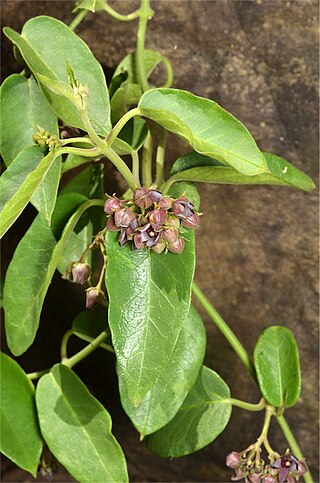Pseudogynoxys chiribogensis is a species of flowering plant in the family Asteraceae. It is found only in Ecuador. Its natural habitat is subtropical or tropical moist montane forests. It is threatened by habitat loss.

Pseudogynoxys is a genus of flowering plant in the groundsel tribe within the sunflower family, native to North and South America.

Pseudogynoxys engleri, also known as Engler's daisy, is a species of flowering plant in the family Asteraceae that is native to Ecuador.
Pseudogynoxys sodiroi is a species of flowering plant in the family Asteraceae. It is found only in Ecuador. Its natural habitat is subtropical or tropical moist montane forests. It is threatened by habitat loss.

Micromeria is a genus of flowering plants in the mint family, Lamiaceae, widespread across Europe, Asia, Africa, and North America, with a center of diversity in the Mediterranean region and the Canary Islands. It is sometimes placed within the genus Satureja. The name is derived from the Greek words μῑκρος (mīkros), meaning "small," and μερίς (meris), meaning "portion," referring to the leaves and flowers. Common names include savory and whitweed.

Quercus benthamii is a species of oak in the family Fagaceae. It is native to the cloud forests of Central America and southern Mexico. It is threatened by habitat loss.
Chenopodium benthamii is a species of shrub endemic to midwest Western Australia.
Pseudogynoxys cummingii is a species of the genus Pseudogynoxys and family Asteraceae. It is one of three species of Pseudogynoxys that are known in cultivation.

Lupinus benthamii is a species of lupine known by the common name spider lupine.

Livistona benthamii is a species of palm. This species is natural distribution is from Cape York to the Archer River in Queensland, the Northern Territory and New Guinea. It is a solitary palm found in open forest near areas that are annually inundated. An example may be seen on the Freshwater lake Walk at the Cairns also known as Flecker Botanical Garden.

Eucalyptus benthamii, commonly known as Camden white gum, Bentham's gum, Nepean River gum, kayer-ro or durrum-by-ang, is a species of tree that is endemic to New South Wales. It has mostly smooth bluish grey or white bark, lance-shaped to curved adult leaves, flower buds arranged in groups of seven, white flowers and cup-shaped, bell-shaped or conical fruit.

Vincetoxicum polyanthum, commonly known as coast tylophora, is a vine in the dogbane family Apocynaceae first described in 1891 by the German botanist Otto Kuntze. It is native to the Australian states of New South Wales, the Northern Territory, and Queensland. In the Australian Tropical Rainforest Plants identification key, it is still treated as Tylophora benthamii.

Amyema benthamii, commonly known as the twin-leaved mistletoe or Bentham's mistletoe, is a species of flowering plant, an epiphytic hemiparasitic plant of the family Loranthaceae native to Western Australia and the Northern Territory of Australia in semi-arid woodland. This species is named in honour of the English botanist George Bentham who between 1863 and 1878 published Flora Australiensis, the first flora of Australia.

Pseudogynoxys chenopodioides, known commonly as the Mexican flamevine, is a climber in the family Asteraceae, native to Mexico, Central America and the West Indies.

Acacia benthamii is a shrub of the genus Acacia and the subgenus Plurinerves. It is native to an area along the west coast in the Perth metropolitan region and Wheatbelt region of Western Australia.
Xylopia benthamii is a species of flowering plant of the genus Xylopia, described by Robert Elias Fries in 1900. It contains one subspecies: Xylopia benthamii dolichopetala. The species is native to Venezuela, Peru, Brazil and Bolivia.
Zygostelma benthamii is a species of flowering plant in the family Apocynaceae native to eastern Asia. It is the only species in the genus Zygostelma and was first formally named in 1890.
Pultenaea benthamii, commonly known as Bentham's bush-pea, is a species of flowering plant in the family Fabaceae and is endemic to south-eastern continental Australia. It is an erect shrub with sharply-pointed, narrow elliptic to linear leaves and yellow to orange and red flowers in clusters at the ends of branches.

Aristida benthamii is a native Australian species of grass. Found in New South Wales and Queensland.
Daviesia benthamii is a species of flowering plant in the family Fabaceae and is endemic to the west of Western Australia. It is an erect, bushy shrub with scattered, cylindrical, sharply pointed phyllodes, and yellow-orange and reddish-brown flowers.











